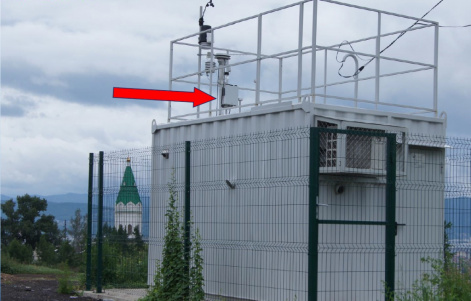In focus: air quality monitoring system and development program of KSC SB RAS
27 February 2020 г. FRC KSC SB RAS

The regular meeting of the Scientific Council of the Krasnoyarsk Science Center SB RAS started with a scientific report. Oleg Yakubaylik, Candidate of Physical and Mathematical Sciences, Head of the Laboratory of Space Systems and Technologies at the Krasnoyarsk Science Center SB RAS, presented the first results of the project for creating an air quality monitoring system. This report was presented in an expanded form the day before at a meeting with the Governor of the Krasnoyarsk Region, Alexander Uss and head of Rosprirodnadzor Svetlana Radionova.
Sensors located in several areas of the city show the dynamics of changes in the amount of suspended particles in the air in two size ranges - 2.5 and 10 microns. In addition, meteorological parameters are being measured. The information is sent to a shared server and processed using original algorithms, being available to all users on the site. Based on the measurements, the generally accepted air quality index is calculated. At the same time, the sensors used by the Krasnoyarsk Science Center SB RAS were certified and carefully calibrated for the conditions of Krasnoyarsk. According to the data obtained for the last year, the most polluted in the city can be considered to be the Sovetskiy district, as well as the villages of Minino and Drokino. The lowest rates of air pollution by suspended particles are observed in Akademgorodok and Udachny microdistrict.
The creators of the system note that its development is not finished. Today, the right bank is poorly covered by sensors. Now the system has about 20 measuring stations, and for an accurate analysis of the spread of dust pollution in the city, at least 60 stationary observation points are required. In the future, it is planned to increase the number of sensors as well as to provide more detailed information on air quality and meteorological conditions. This will allow a more detailed analysis of the situation and suggest an approach to the solution of the air pollution problem in Krasnoyarsk.
In the speech of the members of the Scientific Council, understandable concerns were presented that the analysis and measurements of only suspended particles (dust pollution) could lead to a distortion of the public understanding of the full range of dangerous compounds in urban air. Thus, formaldehyde, benzapyrene and nitrogen oxides, which are not detected in measuring the amount of dust particles, pose a great threat to the population. To determine the concentration of such compounds, other, more expensive and complicated methods are needed.
Academician of the Russian Academy of Sciences, Doctor of Physical and Mathematical Sciences, Andrei Degermendzhi proposed a project for the further development of the monitoring system, which includes three components. Firstly, it is necessary to develop and supplement the monitoring network. According to the corresponding member of the Russian Academy of Sciences, Doctor of Biological, Sciences Mikhail Gladyshev, for an integrated assessment of the impact of air quality on living organisms, it is worth integrating bioassays into this system, which, though not allowing measuring the content of a specific substance, can estimate the effect of the entire amount of pollutants. Secondly, serious refinement of the system for processing and interpreting the obtained data is required, as well as of necessity is its integration with the model of distribution of air flows in the city and inventory of emission sources. And finally, the scientists of the Federal Research Center are able to propose solutions for reducing emissions by introducing new technologies. For example, the transition from burning solid fuels (coal) to their liquefied form, which allows us to dramatically reduce the amount of pollution. Krasnoyarsk scientists also have such achievements.
However, the question arises of financing this work. It is not part of the state task. So you need a third-party source. This could be implemented at a regional or municipal level. But in order to receive such an order, systematic work with potential customers and interested parties is required. For example, a preliminary agreement has already been reached with the Krasnoyarsk aluminum plant on the purchase of a part of the new sensors. The "black sky" problem in the city can be solved only by joint efforts.
The second question briefly reviewed by the Scientific Council concerns the results of the implementation of the development program of KSC SB RAS for 2016-2019. During this time, the main resources were allocated for the development of the material base of the Center for collective use as well as for major repairs. With the funds of the development program allocated by the Federal Agency for Scientific Organizations (since 2019 it has become part of the Ministry of Science and Education of the Russian Federation), amounting to about 500 million, equipment was purchased for the needs of scientific institutes which are part of the Federal Research Center. The Center has fulfilled almost all the tasks used by the state bodies for the efficiency evaluation, such as the number of publications, including those registered in the international Web of Science database; portion of young researchers and scientists engaged in teaching activities; share of total funding received from extrabudgetary sources.
Particular attention was paid to awarding the status of one of the leading scientific organizations in Russia to the Krasnoyarsk Science Center. This will allow receiving additional financing for the further development of the instrument base within the framework of the implementation of the national project "Science" as early as in 2020.
Share:
